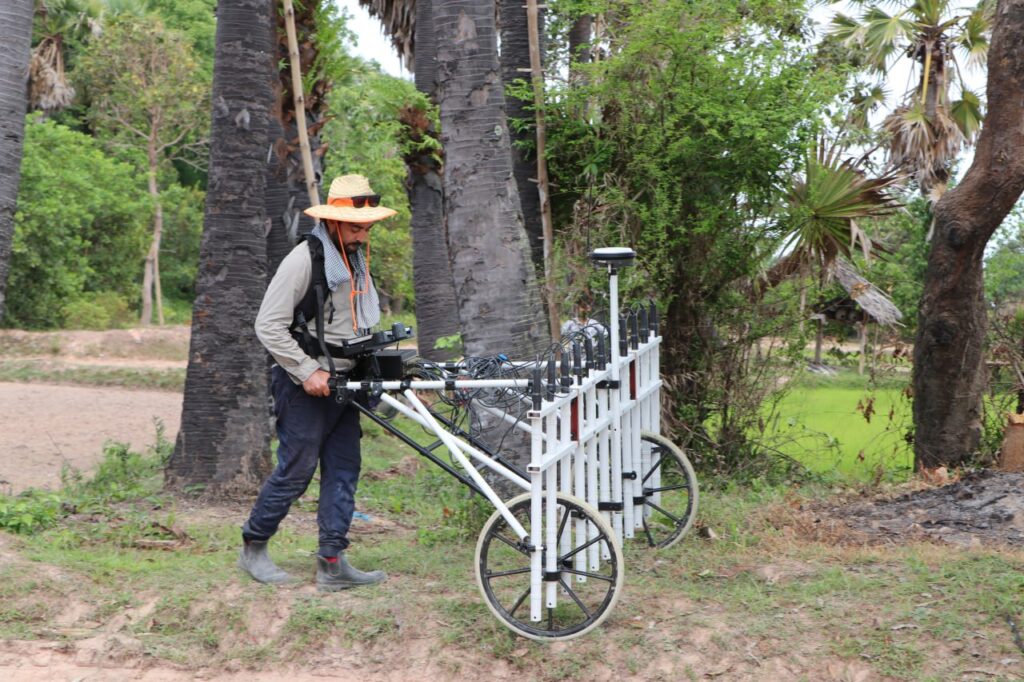គោកអាចម៌ដែក ឬគោកដើមត្នោត ស្ថិតនៅក្បែរភ្នំបូក ក្នុងភូមិស្រែចង្ហូត ឃុំរុនតាឯក ស្រុកបន្ទាយស្រី ខេត្តសៀមរាប ត្រូវបានក្រុមការងារបច្ចេកទេសនៃអាជ្ញាធរជាតិអប្សរា សហការជាមួយសាកលវិទ្យាល័យហាវ៉ៃ និងសាកលវិទ្យាល័យ Flinders University ប្រទេសអូស្ត្រាលី ធ្វើការស្ទង់មេីល ទីតាំង ឡ មុននឹងធ្វើការកំណាយសិក្សាស្រាវជ្រាវ។
លោក អ៊ឹម សុខរិទ្ធី បុរាណវិទូ និងជាប្រធាននាយកដ្ឋានស្រាវជ្រាវ បណ្តុះបណ្តាល និងផ្សព្វផ្សាយ មានប្រសាសន៍ថា គោកអាចម៌ដែកនេះ ជាទីតាំងជើងក្រានស្លដែកបុរាណមួយ ដែលស្ថិតនៅក្នុងឧទ្យានអង្គរ ជាស្ថានីយថ្មីមួយទើបរកឃើញ។ មានភស្តុតាងមួយចំនួនដូចជា សំណល់អាចម៍ដែក បំណែកជើងក្រាននៅលើស្ថានីយផ្ទាល់ និងទំនៀមអ្នកស្រុកស្រែចង្ហូតយកអាចម៍ដែកទៀកិនធ្វើជាថ្នាំព្យាបាលជំងឺអកលឿង នោះនាំឱ្យអាចសន្និដ្ឋានថា ទីតាំងនេះជាកន្លែងស្លដែកបុរាណមួយដែលមានយ៉ាងសំខាន់ក្នុងរាជធានីអង្គរនាសម័យខ្មែរបុរាណ។
លោកបានបន្តទៀតថា កន្លងមកអ្នកស្រាវជ្រាវបានរកឃើញស្ថានីយជើងក្រានស្លដែកបុរាណនៅឆ្ងាយពីរាជធានីអង្គរភាគខាងកើតដូចជា ស្ថានីយស្លដែកនៅភ្នំដែក(ខេត្តព្រះវិហារ) ស្ថានីយស្លដែកនៅតំបន់ខ្វាវ ក្នុងស្រុកជីក្រែង ភូមិគោលនៅស្រុកអង្គរជុំ។ ប៉ុន្តែពេលនេះ យើងបានសិក្សាស្រាវជ្រាវរកឃើញស្ថានីយស្លដែកនៅក្នុងឧទ្យានអង្គរតែម្តង។ ឧស្សាហកម្មស្លដែកពីសម័យបុរាណមានសារសំខាន់ណាស់ក្នុងការផ្គត់ផ្គង់តម្រូវការលោហៈសម្រាប់ផលិតជាសម្ភារប្រើប្រាស់ក្នុងផ្ទះ សម្ភារកសិកម្ម អាវុធយុទ្ធភណ្ឌ និងសម្ភារប្រើប្រាស់ផ្សេងៗទៀតសម្រាប់ប្រជាជនប្រហែល៨០ម៉ឺននាក់ក្នុងរាជធានីអង្គរពីសម័យបុរាណ។
គួរបញ្ជាក់ផងថា នៅក្នុងឧទ្យានអង្គរគេបានរកឃើញស្ថានីយឡស្លដែកចំនួនបីកន្លែង៖ ស្ថានីយទី១ នៅក្បែរសាលាក្រវ៉ាន់ខាងជើងភ្នំបូក ក្នុងភូមិរំចេក ស្ថានីយទី២ នៅគោកអាចម៌ដែកក្បែរភ្នំបូកក្នុងភូមិស្រែចង្ហូត និងទី៣ នៅស្ថានីយត្រពាំងឫស្សីខាងត្បូងភ្នំបូក តាមបណ្តោយផ្លូវជាតិលេខ៦៧៕
អត្ថបទ៖ ឆាយ ផាន់នី
រូបភាព៖ យី សុថា
APSARA National Authority, in collaboration with the University of Hawaii and Flinders University, uses a magnetometer to scan for the ancient iron kiln at the Angkor site.
Kok Ach Dek or Kork Deum Tnaot near Phnom Bok in Sre Chang-o village, Run Ta Ek commune, Banteay Srei district, Siem Reap province was surveyed by the technical team of APSARA National Authority in collaboration with Flinders University, Australia before excavation.
Mr. Im Sokrithy, Archaeologist and Director of the Department of Research, Training, and Communication, said the Kork Ach Dek was the site of ancient iron kilns located in Angkor Park, a newly discovered site. There is some evidence, such as scrap metal, stove fragments on the station itself, and the tradition of the villagers to use the iron ore as a cure for illness, leading to the conclusion that this site is an ancient iron kiln that is important in the capital of Angkor in ancient Khmer times.
He added that in the past, researchers have found ancient iron kilns far from the eastern capital of Angkor, such as ancient iron kilns in Phnom Dek (Preah Vihear province), ancient iron kilns in Khvav area, Chi Kreng district, Koul village in the district, Angkor Chum. But now we have studied and found ancient iron kilns in Angkor Park. The ancient iron industry was important in supplying the demand for metals for home appliances, agricultural equipment, weapons, and other supplies for the 800,000 people of ancient Angkor.
It should be noted that in Angkor Park, three iron kilns are found: the first iron kiln is near the Kravan school north of Phnom Bok in Romchek village, the second iron kiln is on the land of Kok Ach Dek near Phnom Bok in Sre Chang-o village and the third one is at Trapeang Russey in the south of Phnom Bok along National Road 67.
Article: Chhay Phanny
Photos: Yi Sotha
Share:
Our Latest News

លោកជំទាវបណ្ឌិតសភាចារ្យ ភឿង សកុណា អញ្ជើញចូលរួមពិធីក្រុងពាលីនៃព្រះរាជពិធីបួងសួងចម្រើនសេចក្តីសុខជូនព្រះរាជាណាចក្រកម្ពុជា H.E. Dr. PHOEURNG Sackona to attend the blessing ceremony for the upcoming Royal Ceremony to pray for the happiness of Cambodia- 13 April 2025
នៅរសៀល ថ្ងៃអាទិត្យ ១រោច ខែចេត្រ ឆ្នាំរោង ឆស័ក ពុទ្ធសករាជ២៥៦៨ ត្រូវនឹងថ្ងៃទី១៣ ខែមេសា ឆ្នាំ២០២៥ លោកជំទាវបណ្ឌិតសភាចារ្យ ភឿង សកុណា រដ្ឋមន្ត្រីក្រសួងវប្បធម៌និងវិចិត្រសិល្បៈ និងជាប្រធានក្រុមប្រឹក្សាភិបាលអាជ្ញាធរជាតិអប្សរា រួមទាំងថ្នាក់ដឹកនៃអាជ្ញាធរជាតិអប្សរា




